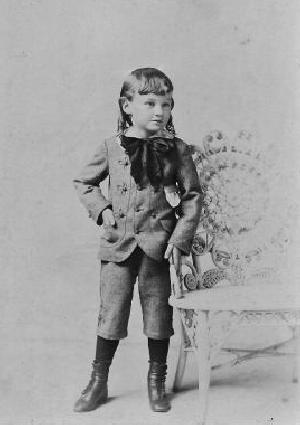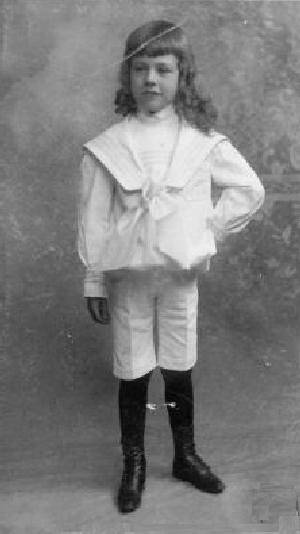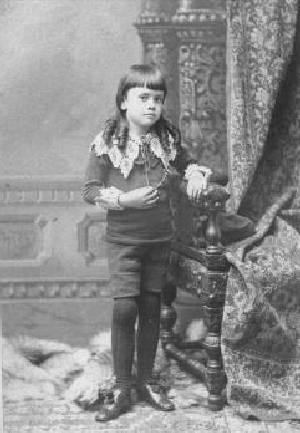3 Years Old
We see quite a number of American 3 year olds wearing ringlet curls. It was oine if the oruncioal ages for boys wearing runglets. At this age many boys in the 19th cebntury had not yet been breeched, but this varied from fsmily to family. Most boys by thus age had ebnough hair that it could be curled. We see family differences beginning to appear at this age. Some parents believed in breeching boys before their curls were cut and others were more prone to cut the curls first. Some did both at the same time. A good example is an Ohio boy who looks to be about 3 years old in the 1890s. Family images are particularly useful because they help define when the children in the family had their curls cut. We have found one image with two young boys. They look to be 3 and 5 years old. The 3-year old has suinglets. The 5-year old has short hair, suggesting that curls in that faily were cut at age 4-years. And it easier to estimate the ages in families with multipile children. We note an unidentified boy with ringlets in the 1850s while his school-age older brothers have short hair cuts. After the turn of the 20th century we see only very young boys wearing ringlets, especially by the late-1890s or early-10s. A good example is Jaspar Barnes.
|
4 Years Old
We note quite a substantial number of boys wearing ringlet curls at age 4 years. Most of the photographic portraits ee ghave found of boys wearing ringlets klook to be about 3-5 years old meaning pre-school boys. And age 4 yearsc was right in the middle of this range. At this age it was for the most part entirely up to the mothers how tghe bioys were dressed abd their hair syled. Often fathers did not pay any attention until boy reached school age, actually often until their teens. This if ciurse varied from family to family. And boys this age largely remained at home under mothers supervision. Boys at age 4 generally did not understand or fully appreciate fashion conventions. Miost if their exoeriebes were centered on the hime and what miother told them. Mother was the center if their wirkd. Abd their oprimary cioncern was in oleasing their parebts abd the attentuiin theu=y received from them. At this age many boys would have liked all the attention mother lavished on them in the styling of ringlets. We do not notice any substantial difference between the style of ringlets worn at different ages, except for length. And at this age, curls could be done at substantial lengths if mothers so desired. A good example is Frank Tuche in the 1870s. We see more and more boys with ringlets at age 4 wearing knee pants rather than dresses and other skirted outfits. Of course chronological trends were involved here. We begin to see fewer boys wearing skirted outfits, especially by the 1890s. A formal portrait shows William Dougherty who looks to be about 4 years old. He was presumably from St. Louis, Missouri because his portrait was taken at the Murillo studio there. The portrait is not dated but we would guess that it was taken about 1905. Another example of a boy about 4 yeas old is a San Jose boy about 1905. We note Ivan Eugene Perry in 1906-07, although thev family is unsure if he was 4 or 5 years old. It is difficult to be any more specific from the photograph.
|
5 Years Old
Age 5 seems to be the last age where we see really large numbers of American boys wearing ringlet curls in the photographic record. Age 5 is an interesting age. Boys at age 5 begin to become a little more aware of things. We suspect that age 5 was the age that some boys would have begun to complain about wearining ringlets. Of course in the 19th century children had less to say about such matters, but that does not mean that they did not have opinions on such matters. A few figure out about Santa. They also begin to notice fashion conventions. Even so they are at this age still largely at home under mother's almost total control. Many parents breeched boys by age 5, but not all and we still see boys that were not breeched and wearing long ringlet curls. This is in part because most boys did not begin school until age 6 years. The photographic record still shows quite a number of boys with ringlet curls. We note an unidentified boy in the 1850s who looks to be about 5 years old. Ringlets do not appear to have been real common for boys at the time. We see a lot more examples in the late-19th century, especially with th appearance of the Fauntleroy craze. We know that Hugh James was 5 years old when he had his ringlets cut. We are not sure though if they were cut when he turned 5. We note an unidentified boy who looks to be about 5 years old. Another good example is Tommy Purcell in 1892. We note Theodore Roosevelt Johnson in 1912, probably just before he began school. The reason we still see many unbreeched boys and boys with ringlets at age 5 years is is in part because most boys did not begin school until age 6 years. School was a factor with boys hair styles and clothing because at school they met other boys both their own age and older. So they began to hear ideas and become acquianted with not only clothing and hair styles other boys were wearing, but what other boys thiought of their hair styles and clothing. Mother was no longer the sole arbitor of theur hair anhd clothing. Today children comnmonly attend pre-school and Kindergarten. This was ot thge case in the 19th century. Most children did not attend any form of school until they turned 6 years old and entered the 1st grade. Girls were more aware and interesred in such matters, but when boys begabn school they were exposed to the opinions and thoughts of others. This did not occur at age 5 years. It would occur at age 6 years when the boys began school. And we do not see boys beginning schoolm still weating ringlet or dessed in skirts. The photographic record is very clear about this. The examples of school age boys with ringlets we have found is virtually entirely portraits mothers had taken at studios as fond remeberances of their little treasures.
6 Years Old
American children generally began school about 6 years of age. The public school system as still evolving in the early 19th centurtu, but after the Civil War (1861-65) this age standard became increasingly standard. This was just the time that ringlets became especially popular for boys. We see boys wearing ringlets before the Civil War, but the photographic record suggests that it was much more common after the War, especially for younger boys. Most children had their hair cut short before beginning school. This is because boys with long hair, especially curls were likely to be teased at school. The vast majority of boys had short hair cuts. There were exceptions such as a Catholic boy in the 1890s. Or a unidentified California boy in 1891. Some of the boys we note with curls seem younger than 6 years old. Even so, boys with curls at school were not very common as can be observed in school portraits. Hiome portrairs are also helpful even if not datred. We note two Wisconsin brothers wearing identical sailor suits during the 1900s decade in Wisconin. They are close in age. One has ringlets, the other does not. They look to be about 5 and 7 years old. This would suggest that the boys had their hair cut when they were about 6 years old. We also note a New York boy who looks to be about 6 years old in the 1850s. We suspect that many of the boys who wore ringlet curls at age 6 and older were boys from affluent families that did not go to public schools. After the very early 20th century we see far fewer boys wearing ringlet curls. One boy who still had ringlets about 1910 was Carl Kellison. We think that he had probably not yet begun school. It shoukld be nioted that not all 6 years olds had begun school. The geberal ruke was that to begin school in Seoptember that children had to be 6 years old are close to tuning 6. Thus is a boy's birtthday was in Ocrber ior larer he had to wait until he wa closer tob 7 years old to begin school.
7 Years
We no longr see very many American boys wearing ribglet curls at age 7 years. This is not to say it was extrodirarily rare or unusual, but the photographic records shows than a lot fewer boys at this age wore ringlets.A major factor of course was that bod began school sat age 6 years. And we do not see boys wearing ringlets to school. A rare school age boy was 7-year old Edwin Bennett in 1916.
8 Years
Very few American boys wore ringlet curls at age 8 years. But we have found a few. One is Martin Wedin. We see Martin with his little sister in a cased Ambrotype, probably during the 1850s. There is no available information about the family.
11 Years
12 Years
We notice Ralph Benton who just turned 12 years of age had his portrait taken wearing ringlet curls with a sailor suit in 1896. Ralph was born in Germany.
HBC
Navigate Related HBC pages:
[Return to the Main U.S. ringlet curl country page]
[Return to the Main ringlet curl page]
[Return to the Main curl page]
[Bangs]
[Long hair]
[Hair bows]
[Caps]
[Collar bows]
Navigate the Boys' Historical Clothing Web Site:
[Introduction]
[Activities]
[Biographies]
[Chronology]
[Clothing styles]
[Countries]
[Bibliographies]
[Contributions]
[FAQs]
[Glossaries]
[Images]
[Links]
[Registration]
[Tools]
[Boys' Clothing Home]
Created: 3:40 AM 11/24/2007
Last edited: 8:47 PM 7/11/2024




